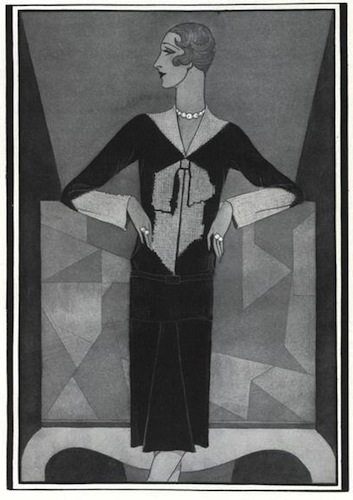
Guinevere Van Seenus in vintage 1930s Schiaparelli, Vogue, May 2012. Photo: Steven Meisel. Image via vogue.com.
Have you heard? The house of Schiaparelli, founded by the legendary Elsa Schiaparelli (1890-1973) and dormant since 1954, has been revived.
Last year Christian Lacroix presented a one-off couture collection for the house, and this week the new head designer, Marco Zanini, presented his first Schiaparelli collection at the Paris couture. (See the Spring 2014 collection on style.com, or read W’s coverage of Zanini’s appointment here.)
The opening look in Marco Zanini’s debut collection for Schiaparelli. Model: Stella Tennant. Image via style.com.
The high-profile revival follows the Costume Institute’s major 2012 exhibition, Schiaparelli and Prada: Impossible Conversations (see my earlier post here). And, timed to coincide with couture week, an auction of Schiaparelli’s personal collection takes place Thursday at Christie’s Paris:
Many of you will be aware of Schiaparelli’s licensed sewing patterns, since she was among the first designers of Vogue Paris Originals. There were also Schiaparelli knitting patterns. If you knit, you can download a free pattern for Schiaparelli’s 1927 Bowknot sweater, updated by Lisa Stockebrand (Ravelry page here):
Like Vionnet, Schiaparelli also saw commercial sewing patterns for her designs in the interwar period, released by companies including the McCall Pattern Company, Pictorial Review, and the Paris Pattern Company. Here is a selection of early Schiaparelli patterns.
This McCall pattern is the earliest Schiaparelli pattern I’ve seen. Dating to the autumn of 1929, it’s a pattern for a blouse, skirt, and coat with angled pockets. It was still shown in a 1930 catalogue:
Here is the illustration of McCall 5839 in McCall’s magazine:
This Schiaparelli pattern from the Paris Pattern Company has some unusual details. The wrap skirt buttons diagonally across the hips and has two slits through which the blouse’s attached scarf can pass, for a suspender effect:
McCall 6981 is a three-piece suit consisting of a jacket, cropped pussy-bow blouse, and sleeveless, bias dress:
Here’s an illustration of this design (centre, no. 14) in the summer 1932 issue of McCall Fashion Bi-Monthly. Elsewhere it calls McCall 6981 a “trick” ensemble, since the blouse and jacket disguise a dress suitable for tennis:
This Benito illustration for Vogue shows a similar Schiaparelli ensemble, worn with a tomato red Sicilian cap:

Schiaparelli beige suit, blue blouse and Sicilian cap; pink jacket and brown skirt, Vogue, May 1, 1932. Illustration: Eduardo García Benito. Image via Corbis.
This Pictorial Review Schiaparelli adaptation dates to late 1933. The dress has interesting details like shoulder flanges, diagonal waist darts, and inverted darts radiating from the neckline:
Here’s the catalogue illustration for Pictorial Review 6764:
Paris Pattern 2286, illustrated in my 1934 Paris and Style Patterns booklet, is a jaunty ensemble consisting of a coat, skirt, and jacket blouse. The description reads, “A superb town and country suit. Just the thing for that week end vacation. Top coat can be worn over any dress. The skirt and jacket blouse make an ideal spectator costume”:
Also in this leaflet is the Schiaparelli dress and capelet ensemble available as a reproduction from the Vintage Pattern Lending Library. The dress has shoulder yokes, puffed sleeves, and a skirt with pointed set-in panels and pair of buttons at the waist; the matching capelet is trimmed with pleating and buttons to the skirt front:
Finally, from McCall’s, this Schiaparelli dinner dress in two lengths dates to winter 1936-37. The bodice back extends into sleeves that are gathered into a heart-shaped bodice:
The pattern is illustrated in the January 1937 issue of McCall’s magazine, which made much of the new, street-length hemline:
Schiaparelli patterns from between the wars tend to lack the surrealist touches we associate with the designer, since many of these were based on couture embellishment, accessories, or notions. (Cricket buttons, anyone?) I remember reading a contemporary 1930s article that said Schiaparelli pieces were so simple, they were too easy to copy. Today one might say it’s her brand of dynamic severity that makes her clothes seem so modern.
Next: Schiaparelli’s postwar Vogue Paris Originals.
Tagged: 1920s, 1930s, couture, designer, fashion, illustration, McCall's, Paris Pattern, Pictorial Review, Schiaparelli, sewing, vintage















